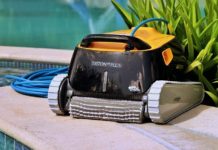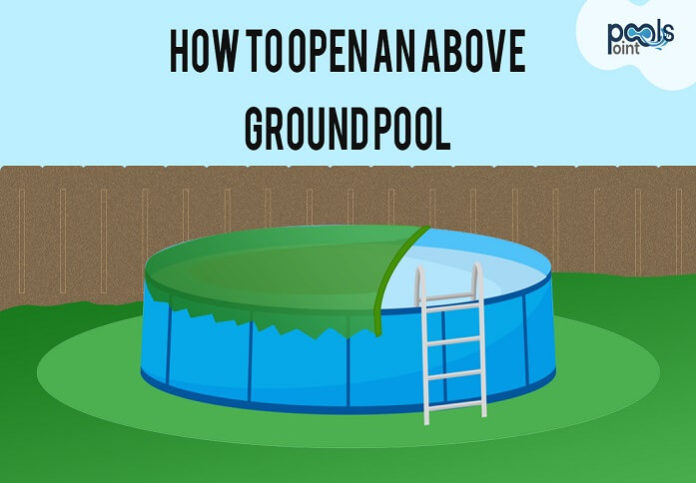Is your above ground pool ready for the next season? These swimming pools can be a great tool for water volleyball, mini laps, or just taking a dip on a hot summer day.
The first step in making pool prepping a DYI project to learn how to open an above ground pool.
Why should you consider opening the on-ground swimming pool yourself? This can save you tons of money and possibly hundreds of dollars you’d normally have to pay a professional.
It’s also good exercise since you’ll be getting in a workout in the process. Opening your own pool is also a plus since it instills pride of ownership.
The process of opening the pool will likely be easier than you might think. Besides that remember the words of 2x Super Bowl-winning coach Vince Lombardi that “Perfect practice makes perfect.” Each year you prep your above ground pool the process the will become easier.
You’ll just need the right pool maintenance supplies, a buddy, and the motivation to get your pool up and running for the new pool season.
Table of Contents
Prep Step: Collect Supplies Needed
Many of the items needed when learning how to open an above ground pool are probably already in your pool shed. The items you don’t have already can be found at a local pool supply store or online retailer like Amazon.
Here are some of the main items you’ll need:
Tool Box
Will you need every type of hand tool manufactured when learning how to open an above ground pool? You won’t. However, it helps to have some basic tools and a mini tool box to keep them organized.
Some of the main tools to have with you include wrench, screwdriver, pliers, and nutdrivers.
If you don’t have some of these tools they’re worth the investment. You’ll need them for tasks like tightening the ladder or drain plugs.
Even if you don’t need all the above-mentioned tools it’s better to have them with you to avoid delaying your pool opening.
[amazon box=”B000PS6NO4″ template=”horizontal”]
Pool Cover Pump
The above-ground pool cover keeps debris like leaves and bugs out of the pool when you’re not using it. The cover also provides other benefits like maintaining the water’s temperature and minimizing evaporation by up to 95%.
However, it can be tough to remove the pool cover when there’s lots of rain on it. The pool cover pump isn’t “cheap” but it’s cheaper than hiring a professional to do the task.
You can also use the pump throughout the year so the cover isn’t damaged by a high volume of water that builds up.
[amazon box=”B0013KCOIW” template=”horizontal”]
Leaf Blower
If you have lots of leaves to clear from your pool and don’t want to spend all day removing them then this is the tool to have. You just connect it to a pool cleaner hose then watch the vacuum gobble up the pool’s leaves.
The best part of this item is you can find many units in the under-$50 price range. Depending on the size of your on-ground pool you probably won’t need a vacuum with an ultra-powerful motor.
[amazon box=”B0007PZN9Q” template=”horizontal”]
Chemical Kit
You have a few different main options. One is a general chemical skit for swimming pools. This will likely have many of the items you’ll need for the start of the pool season.
However, a better option is a chemical kit that’s specifically for pool opening. This will provide everything you’ll need to get your swimming pool ready for the season.
One issue to consider is the maximum pool size the kit is designed for. This will help to make sure the start-up kit is appropriate for the size of your above-ground pool.
Here are some of the must-have items to look for in a kit:
- Stain/Rust/Scale Preventer: Removes mineral staining/scale
- Algaecide: Kills algae
- Chlorine Shock: Removes contaminants like bacteria
- Test Strips: Measure pH, alkalinity, chlorine, etc.
[amazon box=”B002WKQ1B8″ template=”horizontal”]
Car Wash Soap
This type of cleaning product is generally better than a cleaner for winter pool covers. Cover cleaners often aren’t strong enough to sanitize the pool cover effectively.
On the other hand, car wash soap can produce some long-lasting big suds instead of sprinkling the cover with some weak cleaner.
[amazon box=”B0007XQ3CE” template=”horizontal”]
Skimmer Net
These tools make it easier to remove debris like leaves and bugs from your above-ground pool.
When picking one you should look for sturdy frames/nets so the skimmer net will last for several seasons instead of one day. Look for features like fine nets and heavy frames to get the best results.
Another key feature is nets that are attachable to telescopic poles. This extends your reach and allows you to collect more debris each go-over.
It’s definitely something worth considering for large pools since you’ll have problems reaching the middle areas of the pool.
[amazon box=”B000MOM7KK” template=”horizontal”]
Step 1: Clear Off Water Pool Cover
Before you actually remove the pool cover it’s important to remove debris, leaves, and water from the cover.
- Use a pool cover pump to remove any water sitting on the cover (This is a handy tool that helps to get the job done quickly. You can also use it during the off-season to keep the cover as water-free as possible.)
- If you don’t own a pool cover pump or want to invest in one you could also use a sump pump. You should generally expect to pay more for these items but what’s most important is can still get the job done.
- Use a skimmer net to remove debris like leaves and twigs (Make sure to do this process slowly since sharp equipment could damage the cover. The cover has likely been on the pool for several months so it’s worth taking the time to correctly prep its removal.)
- An alternative to a skimmer net is a soft broom. This tool basically does the same job as a skimmer net.
Step 2: Take Off Winter Pool Cover
This is the first step to take after you’ve collected all the item you’ll need after learning how to open an above ground pool.
- As you remove the cover make sure you do it slowly. (The cover might have been installed for up to half a year so don’t rush the process.)
- Make sure to prevent any debris on the cover from dropping into the pool. (It’s likely some dirt, leaves, etc. will drop into the pool. However, the less that does the easier it will be to prep your pool for the swimming season.)
- If your pool also has an air pillow make sure to remove that with the cover (These items help keep the pool cover secure even during the stormiest months. After the air pillow has been removed you can deflate it.)
Step 3: Clean/Store Pool Cover
These covers are usually designed to be used for several years. That said, like other equipment for above-ground pools it’s important to make sure to maintain them properly.
1. Place the cover flat on a large area
Before you lay down the cover make sure the area doesn’t contain any sharp objects, which could potentially damage the cover. Some areas to pick from include a lawn, driveway, or deck.
2. Use water to wash the cover
The first option might seem to be pool cover cleaner. The problem is these items usually just include a mild detergent in a spray bottle.
If your pool cover has been sitting on the pool for several months it’s important to scrub the cover well.
3. Consider car wash soap/brush
Better options are a quality car wash soap and scrub brush. The combination of foamy suds, quality brush, and old-fashioned elbow grease will help remove any dirt and grime that’s caked onto the pool cover.
It will help to boost the cover’s functionality for the next time you use it.
4. Store the cover properly
Put the pool cover in a sturdy/sealed storage container. You can find many options like plastic tubs at Amazon.
Make sure not to cut corners with this step. It’s better to invest in a quality storage container than to deal with rodents climbing into the container and trying to make a meal of your pool cover. They also might try to make a test in the cover, so there’s that.
Step 4: Remove Winter Pool Plugs/Ice Compensators
Here’s another step for mastering how to open an above ground pool.
1. Remove all winterizing pool plugs
Check around the swimming pool and take out all plugs from the openings. That includes from the return jets/eyeball fittings as well as the skimmer bucket.
2. Remove ice compensator
This is an important item if your pool contains and air pillow and you live in a cold climate.
The ice compensator causes the ice to push towards the middle of the pool against the air pillow instead of outward against the pool’s walls.
3. Reinstall skimmer baskets/return jets
In the case you used a skimmer plate/cover during the winter remove it. This unit is designed to keep the skimmer water-free during the winter and keep the swimming pool filled.
Then after removing it the water flows easily after reactivating the filter system.
Step 5: Fill Up the Swimming Pool
This step isn’t always required and is based on the steps you took when closing the pool.
1. Use a hose filter to add water
This allows you screen out any impurities, which is important for the function and safety of your above-ground pool. Make sure to pick a quality hose filter.
2. Fill the pool to halfway mark of skimmer’s opening
Step 6: Reinstall the Pool’s Deck Equipment
1. Check deck equipment
Make sure to inspect the equipment like ladders, jumping platforms, lifts, and handrails before you reinstall them.
What should you look for? Check for wear and damage. If an item seems worn out damaged, or rickety you should replace it immediately.
The old-school rule of “safety first” should always be followed when maintaining your swimming pool.
2. Reinstall all deck equipment
Make sure this is done properly. This is the time to give the items a second check. If anything seems flimsy or worn out then you should consider going to the world’s largest e-commerce site Amazon and placing an order.
This will help to give you peace of mind you’re taking the right steps after learning how to open an above ground pool.
For example, if the pool ladder is technically installed but seems a little shaky make sure to fix the problem as soon as possible. As time passes the problem will get worse and possibly dangerous.
Step 7: Set up Equipment Like Pump, Filter, etc.
You’re getting closer to getting your above-ground pool up and running. After adding the hardware you’ll be closer to completing the process of opening your pool.
1. Remove all winterizing plugs/gauges
This includes the drain plugs and pool filter’s gauges. It’s an important step to learn about how to open an above ground pool.
2. Use a standard plug to replace each winterizing plug
Make sure you select the right items for your particular on-ground pool. If you’re unsure about this issue then make sure to review your pool’s owner’s manual or browse the web to find out the answer.
3. Attach the system’s hoses to equipment
You should also make sure to double-check all connections to verify they’re secure.
Here are some of the connections to make sure you take care of:
- Connect skimmer to pool pump
- Connect pump to filter
- Connect filter to filter equipment like chlorinator/heater
Note: If you don’t have any of those items attach the hose to the return inlet.
4. Turn multiport valve to ‘filter’ position
The caveat is your pool might or might not contain this valve so it’s another item you should research to find out whether or not that’s the case.
Step 8: Start Pump/Filter
1. Start up the pump/filter
Here’s the next step after learning how to open an above ground pool. Make sure the unit is working properly without drips/leaks.
It’s also critical to verify the ground wires are connected to the pump correctly. This will help to avoid possible safety issues, which is critical when operating an above-ground pool.
2. Prime the pump if necessary
If your system is running dry then you might need to prime the unit. Here are the steps to take:
- Shut off the filter system
- Remove pump lid
- Add water (e.g. bucket of pool water or garden hose)
This will provide your pump with the juice it needs to begin pumping water again. Replace the pump lid, turn to tighten it, then start up the system again.
3. Backwash the filter after starting up the filter
That’s for filters that use sand or diatomaceous earth (DE). The process will be slightly different but it’s still critical to know the different steps to take.
The primary difference is adding DE after backwashing pool filters that use the tiny fossilized organisms.
First Step
Before you get started with the process make sure to shut off the pool’s filter pump before you turn the filter valve to prevent the gasket or internal parts from getting damaged.
This could cause various results that could cause a world of trouble involving the filter tank as well as pipe valves/fittings.
Sand/DE Filter Settings
FILTER: It should be kept here at all times except when you’re backwashing/rinsing/wasting.
RINSE: After backwashing use this setting for 15 seconds to rinse sand filter tank
RECIRCULATE: Use this filter bypass setting in the case the filter is leaking/broken so you can keep circulating water.
BACKWASH: This setting reverses the filter’s flow and sends water out of waste line. Verify the valves are open and backwash hose has been rolled out.
CLOSED: This setting closes off flow from pool, which is usually to work on equipment or keep the water backflow out of filter.
Don’t operate pump when valve is closed, and never use it as a winterizing setting. For winter pop-up the handle halfway between 2 positions.
WASTE/DRAIN: This is another filter bypass setting that sends the water out of hose rather than returning the H2O to pool.
This particular setting lowers pool water level. It’s also used to vacuum waste when vacuuming dust, silt, algae, and other debris.
Backwashing Sand/DE Filters
When backwashing your filter it’s critical to know the different settings on the filters so you can operate the unit properly.
For example, the steps for backwashing a DE filter will be different for a side and multi-port valve.
Step 9: Clean Up Pool
If your pool is clean and pure you then move on to the next step of opening it. This will require you to do some tough work.
1. Brush the pool
This includes the walls and even hard-to-reach crevices. This will help to make your above-ground swimming pool as tidy as possible.
2. Vacuum the swimming pool
This will help to pick up debris that’s collected inside the pool. It’s highly advisable to invest in a quality vacuum in order to get the best results.
3. Scrub the floor
Following a long winter it’s also important to give the pool’s floor a thorough scrubbing.
4. Skim the surface
After cleaning the pool the next step is to skim the water’s surface to collect floating debris like leaves and bugs.
Step 10: Use Chemical Kit
The next step after learning how to open an above ground pool is to get out the chemical kit for your swimming pool.
1. Test acidity/basicity (pH) of the water
It’s critical for your swimming pool’s water to be chemically balanced.
You can handle this testing yourself or have a local poor dealer test it for you. This will cost some money but it will be worthwhile to make sure your pool is chemically balanced.
2. Shock the water
You have a few options for a chlorine shock:
- 2 pounds pool shock for each 10,000 gallons of pool water
- 2 gallons pool shock for each 20,000 gallons of pool water
This is a “double shock” using 2x the normal amount of shock. The result is a 1-2 sanitizing punch so the water is definitely ready for people to swim in.
Note: It’s important to shock the water either at dusk/night to prevent the shock from getting burned off too quickly.
Step 11: Complete the Process
The next steps in how to open an above ground pool are the last ones to complete.
1. Run pool pump for 24+ hours
Vacuum out debris that shows up in the process.
2. Test the pool water again
If the results are what you’re looking for then it’s pool party time!
3. Make a pool maintenance schedule
Like maintaining anything else it’s important to maintain your pool on a regular basis during the swimming season. This will help to keep everything as smooth as possible.
On the other hand, failing to do that can cause various problems that will affect the pool’s operation and possibly even result in water safety matters.
Step 10: Use Chemical Kit
The next step after learning how to open an above ground pool is to get out the chemical kit for your swimming pool.
1. Test acidity/basicity (pH) of the water
It’s critical for your swimming pool’s water to be chemically balanced.
You can handle this testing yourself or have a local poor dealer test it for you. This will cost some money but it will be worthwhile to make sure your pool is chemically balanced.
2. Shock the water
You have a few options for a chlorine shock:
- 2 pounds pool shock for each 10,000 gallons of pool water
- 2 gallons pool shock for each 20,000 gallons of pool water
This is a “double shock” using 2x the normal amount of shock. The result is a 1-2 sanitizing punch so the water is definitely ready for people to swim in.
Note: It’s important to shock the water either at dusk/night to prevent the shock from getting burned off too quickly.
Step 11: Complete the Process
The next steps in how to open an above ground pool are the last ones to complete.
1. Run pool pump for 24+ hours
Vacuum out debris that shows up in the process.
2. Test the pool water again
If the results are what you’re looking for then it’s pool party time!
3. Make a pool maintenance schedule
Like maintaining anything else it’s important to maintain your pool on a regular basis during the swimming season. This will help to keep everything as smooth as possible.
On the other hand, failing to do that can cause various problems that will affect the pool’s operation and possibly even result in water safety matters.
CONCLUSION
We’ve just reviewed the basic steps needed to open your above ground swimming pool. You can find several options for the materials you need at Amazon.
It’s the world’s largest online retailer and recently became the second US-based company worth $1 trillion.
After learning how to open an above ground pool it’s just a matter of getting started. The process will get easier as you go through the steps at the beginning of each pool season. Dive on in!









